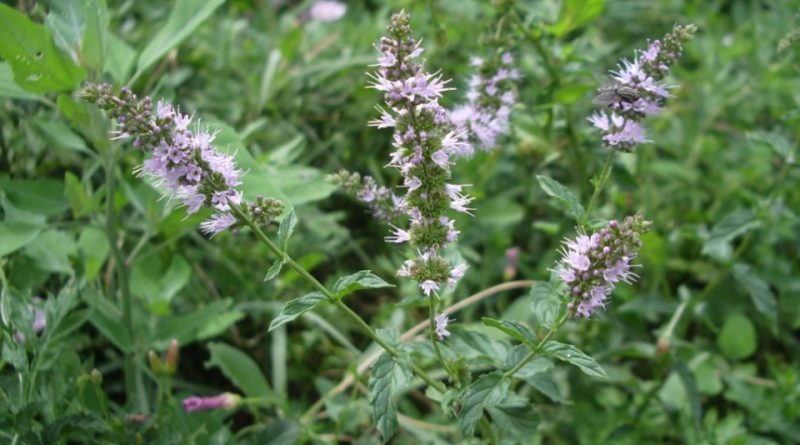Mentha spicata
Mentha spicata
The spearmint (Mentha spicata L., 1753) is a perennial herbaceous species of the Lamiaceae family.
Systematics –
From the systematic point of view it belongs to the Eukaryota Domain, Reign Plantae, Sub-Trinchebionta Subdivision, Spermatophyta Superdivision, Magnoliophyta Division, Magnoliopsida Class, Asteridae Subclass, Lamiales Order, Lamiaceae Family, Mentheae Tribe and then to the Genus Mentha and the Species M. spicata.
Etymology –
The term Mentha comes from the Greek μίνθᾰ mínthă which is an unfortunate river nymph, daughter of the god Cocytus (but it is also a mythological river), which was transformed into a grass by Persephone because she loved Dite, and was used for the first time by Gaio Plinio Secondo (Como, 23 – Stabiae, 25 August 79), writer, admiral and Roman naturalist.
The epithet spicata comes from spíca spiga, spilla: that is with spike inflorescences.
Geographical Distribution and Habitat –
The spearmint is a plant native to Mediterranean Europe widespread in Europe everywhere (excluding Russia and the Iberian Peninsula) and in the Mediterranean area in Anatolia, Transcaucasia, Mediterranean Asia and Egypt.
In Italy it is present everywhere up to 1,200 meters.
Its habitat is characterized by wet calcareous or siliceous soils with neutral pH and high nutritional values.
Description –
The spearmint is recognized by the stoloniferous stems, erect or ascending, branched in the upper part that can reach one meter in height. The leaves are opposite, ovate-lanceolate with acute apex and serrated edges. The surface is covered by simple little protruding ribs and is smooth or wrinkled. The stipules are absent. The leaves have dimensions of 1.5 – 3 cm in width and 5 – 9 cm in length.
The hermaphrodite flowers, almost sessile or briefly pedicellated, of 3-4 mm, are pink-purple, gathered in a fusiform spike at the apex of the stems.
The whole plant has a strong aromatic smell (unpleasant). The aromatic substances (ethereal oils) are contained within glandular hairs.
The schizocarpic fruit is a microbasario (tetrachenium or tetranucula) with 4 mericarps of 0.6-0.8 x 0.4-o, 6 mm, ellipsoid, brown in color, with large and white insertion surface.
Cultivation –
The cultivation of this species, like all the minds, can start from transplanting by cutting tip or by planting pieces of rooted stolons; moreover it can be cultivated both in pot and in full earth.
The best time to sow or transplant it is spring. If the winters are very cold and the summers are very hot it is likely that the plant may be damaged because, above all the frosts, affect the correct growth and oxygenation of the plant. For this reason, temperatures should be moderate.
Mentha spicata needs light to grow. The soil must be sufficiently moist to preserve moisture, without exaggerating. For this reason, it is important to water it often without overdoing it. In the seasons it can be watered every day.
If the plant is started with seeds, wait for the plant to reach 15-20 cm to make the first pruning: it will take about 4 or 5 months from sowing. It can be pruned in the spring or late summer.
For the harvest, the cut twigs can be dried and then preserved. They should be left to dry in the shade for 3 or 4 days and then placed in glass jars or plastic food bags. In this way, you can use your mind all year.
Uses and Traditions –
Mentha spicata has been an aromatic plant known for quite some time.
In the sixteenth century, the agronomist Gabriel Alonso de Herrera explained that, apart from giving an extra touch to many stews, the mentha spiccata, placed between the clothes, protected the heads from the attack of the moths and made them fragrant. It is precisely the smell, in fact, that which converts this type of mint into an insect repellent, including lice.
Despite this, this plant is mainly used to flavor soups and stews and to give flavor to juices and other cold drinks. There are many dishes that can be seasoned with mentha spicata that can be grown in vegetable gardens and pots, embellishing balconies and terraces.
Used for a long time, this plant, according to popular medicine, has the following medicinal properties:
– antiseptic (property of preventing or slowing the development of microbes);
– antispasmodic (reduces muscle spasms, and also relaxes the nervous system);
– carminative (favors the escape of intestinal gases);
– diuretic (facilitates the release of urine);
– stimulating (invigorates and activates the nervous and vascular system);
– stomachica (facilitates the digestive function);
– for external use, as an oral deodorant and antiseptic.
The dried buds and leaves used in Chinese folk medicine are used in this plant.
Also in China this plant is cultivated as a source for green mint oil, an essential oil used to flavor candies, toothpaste, chewing gum and more.
Preparation Mode –
The leaves and flowering tops can be used fresh or dried in a shady and ventilated place and must be kept away from the light and dry.
The edible parts of the spearmint are the leaves (raw or cooked) with which you can make tea, or they can be used as a condiment / spice. The very aromatic leaves of the spearmint are in fact used to give flavor to salads, omelettes, desserts, sauces, ice creams and fruit salads. Very used also in the preparation of liqueurs and syrups.
Guido Bissanti
Sources
– Acta Plantarum – Flora of the Italian Regions.
– Wikipedia, the free encyclopedia.
– Treben M., 2000. Health from the Pharmacy of the Lord, Advice and experiences with medicinal herbs, Ennsthaler Editore
– Pignatti S., 1982. Flora of Italy, Edagricole, Bologna.
– Conti F., Abbate G., Alessandrini A., Blasi C. (edited by), 2005. An annotated checklist of the Italian vascular flora, Palombi Editore.
Attention: Pharmaceutical applications and food uses are indicated for informational purposes only, do not in any way represent a medical prescription; therefore no responsibility is assumed for their use for curative, aesthetic or food purposes.


